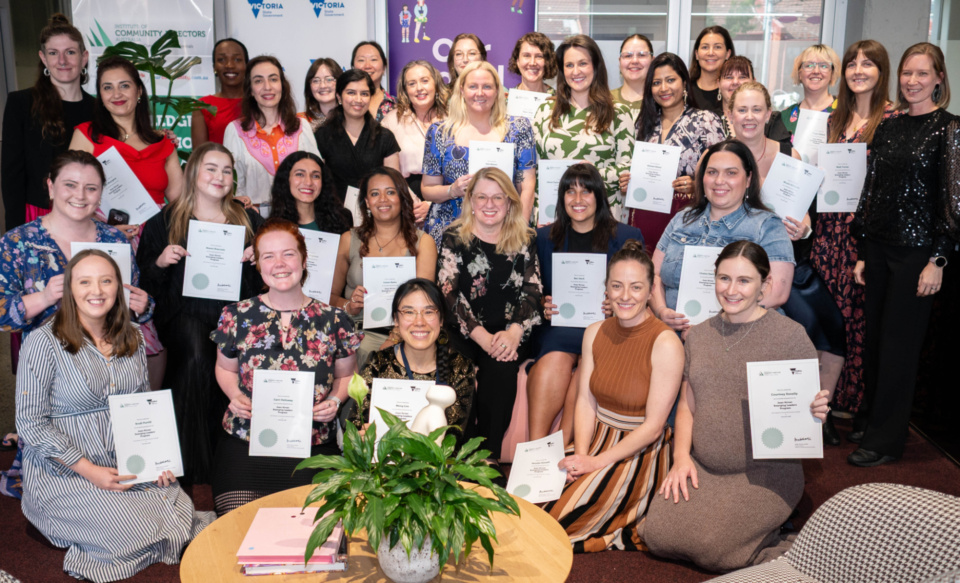
Burnout costing billions in the NFP sector
Posted on 11 Dec 2025
Community Directors trainer Jon Staley knows from first-hand experience the cost of ignoring…
Posted on 17 Jul 2025
By Alex Green, CEO, The Arthritis Movement

Australian charities and not-for-profits (NFPs) are facing six forces that are driving strategic mergers.
These include:
"For many NFPs, digital delivery is exposing duplication and prompting tough questions: why maintain parallel structures when you can combine efforts, free up funds, achieve greater consistency and scale up impact?"

In this climate, mergers are not signs of failure but a strategic response. By collaborating or merging, organisations can combine resources, strengthen programs, expand impact and improve resilience.
Let’s look at each of those six forces in detail.
Accelerated by the covid-19 pandemic, our interactions are moving online. Digital channels such as telehealth, virtual counselling, e-learning and social media enable us to serve clients anywhere, anytime and at scale. Now that Zoom, Teams and social media platforms are ubiquitous, local and state-based boundaries are less relevant. Maintaining federated structures is costly – they require extra IT systems, offices, admin and management – whereas online services can be delivered nationally or even globally.
After covid, it became clear that Arthritis NSW and Arthritis Queensland were essentially duplicating the same work and the same operational structure, with most services and supports provided online. So, the CEO of Arthritis Queensland and I (as CEO of what was then Arthritis NSW), backed by our progressive boards, actively explored opportunities for collaboration. The benefits in terms of client numbers, service breadth and efficiency became quickly apparent – and it was on this basis that the merger to form the Arthritis Movement was later explored.
For many NFPs, digital delivery is exposing duplication and prompting tough questions: why maintain parallel structures when you can combine efforts, free up funds, achieve greater consistency and scale up impact?
For-purpose organisations face significant public policy changes. Internationally, major funders have trimmed their aid budgets, and Australia’s contribution to international aid remains low at around 0.18% of gross national income (GNI). Closer to home, social causes such as diversity, equity and inclusion initiatives and refugee assistance see fluctuating public support. Overseas aid organisations and those advocating for social change are feeling the pinch.
In aged care, the 2021 Royal Commission into Aged Care Quality and Safety recommended a suite of changes to revolutionise the sector. While of course they ensure better care for older Australians, they elevate costs and compliance burdens, and many small aged care providers are weighing mergers or partnership models to survive. And there are more reforms coming soon.
As Adam Woods, executive director, Scalabrini Villages explained: "There's no escaping the reality that recent policy shifts are driving organisations toward consolidation.”
He says these changes aren't temporary, but are “structural transformations that demand new strategic thinking”.
As a result, “mergers offer scale, resilience, and the ability to navigate increasingly complex bureaucratic systems. They can (and should) also be the catalyst for genuine reinvention.”
He urges organisations to “use mergers as an opportunity – not just to streamline overheads, but to re-centre around authentic community needs and deeply held future customer expectations”.
In Disability Employment Services, the government has restructured funding in recent years, with another round of consolidation anticipated in 2025. Small agencies sometimes struggle to secure contracts on their own. Merging can strengthen their bid capacity, widen the range of services they provide, and help them stay competitive in a tougher funding environment.
Duncan Wakes-Miller, CEO, Northside Disability, told me that “for small providers, going it alone is no longer sustainable”.
“Rising NDIS costs and lagging price adjustments are eroding margins and increasing risk,” he said.
Instead, “strategic collaboration, through shared systems, workforce pooling, and smarter technology, is essential to staying viable”.
As he explained, organisations that innovate and consolidate now will shape a stronger, more efficient sector.
“It’s not just about surviving, it’s about protecting participants, lifting quality, and ensuring long-term impact. The path forward demands bold partnerships and a shared commitment to doing more with every dollar,” Wakes-Miller said.
Regulatory shifts also help. Efforts to streamline fundraising laws across Australia simplify nationwide operations – we increasingly all speak the same corporate language. And there is an increasing number of examples of government funders requiring small, aligned providers to consolidate. The wonderful Meals On Wheels (still operating through hundreds of small local organisations, very reliant on volunteers) has multiple examples of government funders requiring them to consolidate for funding purposes.

The National Disability Insurance Scheme (NDIS) has injected much-needed funds into disability services since 2016, but the model sets rigid prices that rarely cover actual service costs. According to a 2025 study by the Centre for Public Value at UWA, operating expenses at some providers climbed by 20 per cent over two years while government price adjustments lagged far behind.
On top of that, many disability organisations face a more complex client base than other organisations, plus workforce shortages (pushing wages higher). The federal government has indicated it wants to curb NDIS expenditure growth, which could further restrict future payments or eligibility. It’s becoming harder and harder for small organisations to do good work under the NDIS.
“For disability employment funding growth, partnerships and innovation are not optional – they’re imperative. Smaller providers won’t be able to thrive alone under conditions that demand efficiency and scale. We strengthen and broaden our service offerings by pooling our expertise and resources. Status quo isn’t an option: proactive collaboration and creativity will enable us to maximise impact for every person we support.” Duncan Wakes-Miller, CEO, Northside Disability.
Consolidation is increasingly attractive in this scenario. By merging, two or more providers can share staff, systems and suppliers and cut overhead – all crucial for staying afloat in the face of disappearing margins and unpredictable policy shifts.
No two ways about it – traditional fundraising is under strain. Inflation and a heightened cost of living erode donors’ ability (and willingness) to give. Fewer donors gave in 2023 than in prior years, and the direct marketing and event markets are increasingly crowded.
Generational change is also reshaping donor behaviour. Younger generations often donate online and give sporadically (to causes) rather than consistently (to an organisation), and increasingly expect (real-time) impact updates. This demands sophisticated digital marketing and transparent reporting, and charities find themselves pouring more money into tech and communications, just to compete in an overcrowded field, or see reliance on and investment in traditional fundraising going up in smoke.
Small volume, high value philanthropy (high net worth individuals, corporate giving etc) is showing consistent growth. However, small organisations that look just like the others around them, that struggle for attention, that won’t or can’t invest to meet contemporary expectations (see point 6, below) or that don’ have sophisticated, progressive strategies to address social issues are unlikely to appeal to top end philanthropy.
Boards are increasingly open to merging so they can combine supporters, centralise campaigns, and reduce costs while creating an organisation that resonates with progressive donors seeking large-scale impact.
Across the not-for-profit landscape, organisations report difficulty filling roles and keeping good staff. As more commercial businesses offer the sorts of staff incentives that NFPs used to “own” (flexible working, wellbeing support, bonus days off, social impact measures, investment in employee engagement etc), convincing someone to work for an NFP over a better-paying “values driven” corporate is hard. We ask people to work hard, often long hours while paying poorly, hoping that an alignment of values will keep generating discretionary effort. The growing complexity of community services (compliance regime, contemporary expectations, increasingly challenging fundraising market etc) makes this even harder. For many this is not sustainable and leads to high turnover. The ageing of the workforce in some sectors (especially health care, aged care and disability care) looms as an additional challenge.
A merger can offer easier recruitment and better retention: larger teams provide better career pathways, peer support, and staff development opportunities. Merged entities typically have the resources to invest in leadership programs or upskilling, and often a new energy or a new brand that appeals to employees. The Arthritis Movement can now offer double the opportunities for staff to move roles or teams and learn new skills while staying with the organisation they love. We can even offer an interstate location!
Funders, regulators and donors are increasingly looking for solid evidence of outcomes. Impact measurement – tracking not just outputs but real social change – requires tools and data analysis that can be expensive or complicated. By consolidating, two organisations might afford a shared impact evaluation specialist or a robust software platform.
I was surprised – and pleased – to see how prominent outcome measurement and reporting was in the Not-for-profit Sector Development Blueprint, released in November 2024. This report also underlines the growing importance of reducing duplication and increasing collaborative approaches.
At the same time, environmental, social, and governance (ESG) standards are no longer just for corporates. Larger not-for-profits are expected to demonstrate sound governance, responsible resource use and inclusive practices. This can be a steep climb for smaller charities that lack the capacity to undertake detailed ESG reporting. A merged or collaborative structure might help spread those costs and commitments. ESG themes are also evident through the NFP Sector Development Blueprint.
None of these forces means a collaboration or merger is the only path forwards. Innovation, especially through emerging technology, also presents opportunities for NFPs to carve out a more impactful or sustainable future.
However, these factors do create conditions where leaders should consider whether a strategic alliance or merger could amplify impact, reduce duplication, and unlock new funding.
“In a tightening funding environment, waiting isn't an option. We must treat every challenge as an opportunity to reinvent ourselves. For some, strategic mergers and bold innovation may provide opportunities to multiply our impact by combining strengths and embracing new technologies or service models. Those who shrink will falter – those who grow strategically and innovate will define the future of our sector. Our focus must be long-term: scale what works, adapt continuously, and ensure our organisations thrive sustainably.” Duncan Wakes-Miller, CEO, Northside Disability.
A well-executed merger isn’t simply a fallback. It can transform your impact, reset the opportunities available to you, realign your relationship with customers, rejuvenate your brand, make over your culture, galvanise staff, and expand services to more communities.
"Mergers are often seen through a purely operational or financial lens. But a merger done right is an exercise in profound customer empathy – an invitation to pause, listen, and deeply understand what communities genuinely value. Organisations that see mergers as opportunities for deeper alignment with their communities' future aspirations – not just internal optimisation – will be those best positioned to deliver lasting impact." Adam Woods, executive director, Scalabrini Villages
If you are feeling the pressure of these six forces, or see the opportunity to “do more good”, exploring the potential for collaborations and even a merger should be on your agenda.
Alex Green is the CEO of the Arthritis Movement and the founder of Loom Consulting, which supports for-purpose organisations with mergers, collaboration and change management.

Posted on 11 Dec 2025
Community Directors trainer Jon Staley knows from first-hand experience the cost of ignoring…

Posted on 10 Dec 2025
As a qualified yoga instructor who learned the practice in her hometown of Mumbai, Ruhee Meghani…

Posted on 10 Dec 2025
Anyone working in an organisation knows it: meetings follow one after another at a frantic pace. On…

Posted on 10 Dec 2025
Stressed, overwhelmed, exhausted… if you’re on a not-for-profit board and these words sound…

Posted on 10 Dec 2025
The Institute of Community Directors Australia trains over 22,000 people each year, which gives us…

Posted on 03 Dec 2025
Many not-for-profit (NFP) board members in Australia are burnt out, overwhelmed and considering…

Posted on 26 Nov 2025
A roll call of Victoria’s brightest future leaders has graduated from a testing and inspiring…

Posted on 12 Nov 2025
At the Institute of Community Directors Australia, we believe that stronger communities make a…

Posted on 12 Nov 2025
Like many Community Directors members, Hazel Westbury is a community leader who isn’t easily…

Posted on 11 Nov 2025
I’ve seen what happens when fear of conflict wins out over taking a principled stand.

Posted on 11 Nov 2025
‘It’s not a question of enough, pal. It’s a zero-sum game. Somebody wins and somebody loses’.

Posted on 11 Nov 2025
Progressive economic Richard Denniss believes the constant hunt by governments for the political…